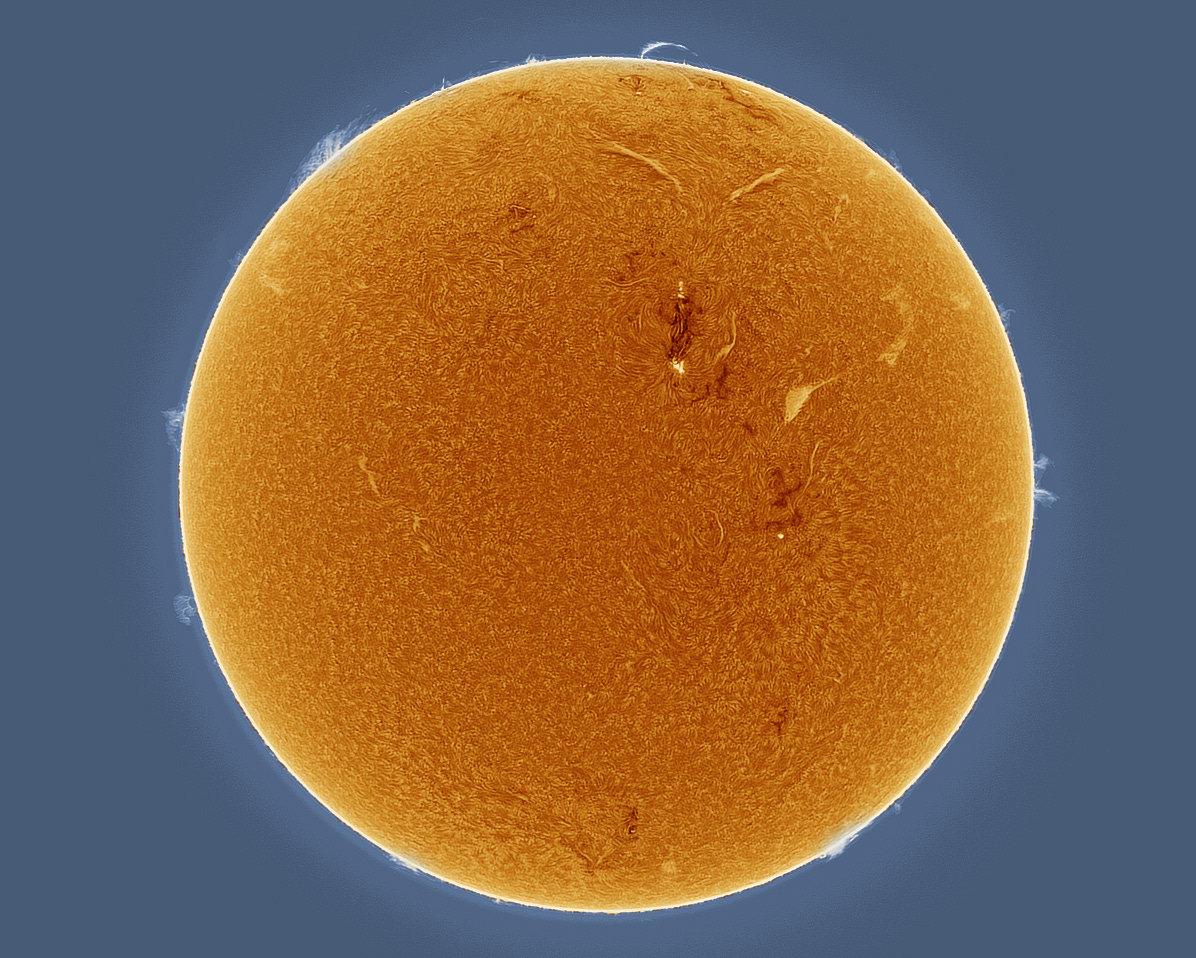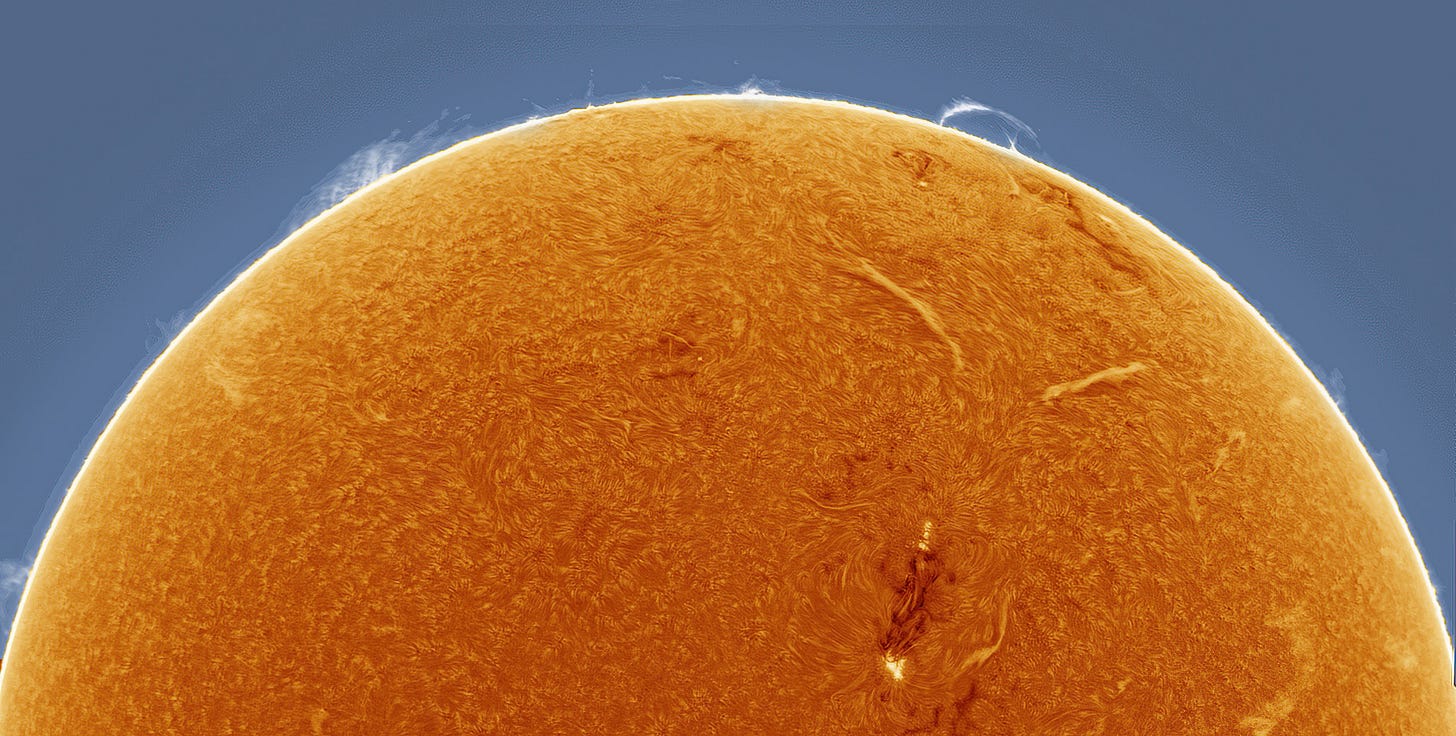Going Solar
Or, How I Learned to Stop Worrying and Love the Sun

For observers like me who live north of the 50th parallel, the few weeks before and after summer solstice never grow dark enough for serious stargazing, and few stars at all are visible until after midnight. It’s a little frustrating. But a few years ago, impatient and hungry for starlight on an early summer evening, I happened across the words of the famous telescope builder and solar astronomer George Ellery Hale who wrote, “The Sun is a star, the only star whose phenomena can be studied in detail.” Of course, the Sun! If I was going to stargaze in the early summer months, the star I was going to gaze at would be the Sun.
I already owned a “white-light” solar filter for one of my telescopes. It showed sunspots, the sandpapery solar photosphere, and the subtle darkening of the solar disk towards its limb. It’s a nice view, but not spectacular, which is why serious solar observers eventually turn to specialized (and pricey) ‘hydrogen alpha’ solar filters that show a far more striking view of our home star. So I bit the bullet and bought a small 60mm telescope with a dedicated H-alpha filter, turned it towards the Sun, and climbed the learning curve to get the most out of this little instrument.
The view was astonishing! The Sun looked like a blood orange suspended in blackness, with flamelike prominences and a forest of needle-like spicules emanating from the solar limb, feather-like filaments on the solar disk, and gnarled knots of plasma enveloping ever-changing sunspots. Best of all, unlike most sights in the night sky, features on the Sun changed from day to day and sometimes over just a few hours. The look is different from night-time astronomy - there’s no ‘diamond dust on a velvet background’ aesthetic that you see in the dark night sky - but the sun close up offers a unique and beautiful vista unlike any other in nature.
It’s awe inspiring - and a little unsettling.
The Sun is big - a hundred times the Earth’s diameter and a million times its volume. In the image below, three or four earths would fit under the little looping prominence at the top of the solar disk. That’s easy enough to grasp.
But a look at the ruby solar disk also leads an observer to consider that we live at the discretion of a nuclear-fueled stellar colossus that generates a staggering amount of power.

The Sun produces its energy through nuclear fusion in its core where protons and electrons reach a density more than ten times that of lead and a temperature of 15 million degrees Celsius. In a multi-stage nuclear reaction discovered in the 1930s, four protons fuse together into a single helium nucleus with a tiny fraction of the mass of the protons converting into pure energy. How much energy? Just one gram of hydrogen fused into helium releases enough energy to (in principle) power an average house for two years, and the Sun has enough hydrogen to release as much energy as 10 billion hydrogen bombs every second for billions of years. Energy generated in the solar core works its way to the solar photosphere and out into space over tens of thousands of years - the light and heat that warms your bones this afternoon took only eight minutes to travel from the Sun’s outer layers, but it began its journey in the solar core back when Neanderthals still walked the Earth.
The fearsome amount of energy emanating from the sun’s core is held in check by the far weaker but more relentless force of gravity. The energy produced in the core wants to blow the Sun apart, but weight of the star’s massive outer layers pushing inward holds it together. This state of uneasy coexistence is called hydrostatic equilibrium and it keeps the Sun stable in brightness to within about 0.1%, steady enough to make life on Earth fairly pleasant despite it proximity to such an immense power source.
This happy state isn’t entirely stable, however. As the Sun burns through its allotment of hydrogen, the rate of energy production slowly decreases, which allows the outer layers to squeeze the solar core even more, which accelerates the rate of energy production and increases the Sun’s brightness by about 1% every hundred million years. That increase in brightness will surely affect the Earth’s biosphere - in half a billion years, the surface of our planet will be too hot to sustain nearly any form of life (as we currently understand it).
After that, the Sun runs out of hydrogen to burn in the core and undergoes significant changes to its inner structure that will balloon the star outwards as a red giant giving the entire Earth, or what’s left of it, a very bad sunburn indeed.
As I say, solar observing can be a little unsettling and awe inspiring - and always worth the effort. But the Sun’s unruly future is a concern for another day - and very likely for species that won’t exist on Earth for tens of millions of years. Our place now is to enjoy our powerful but placid star, to soak up its warmth on a summer day, and to exercise our imaginations and intellect to try to understand, at least a little, how nature works.

